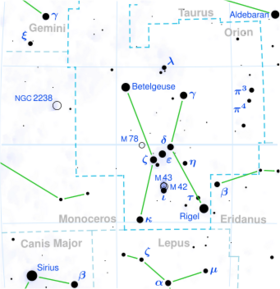Astronomy:51 Orionis
| Observation data Equinox J2000.0]] (ICRS) | |
|---|---|
| Constellation | Orion |
| Right ascension | 05h 42m 28.63240s[1] |
| Declination | +01° 28′ 28.6714″[1] |
| Apparent magnitude (V) | 4.90[2] |
| Characteristics | |
| Spectral type | K1III[3] |
| U−B color index | +1.06[2] |
| B−V color index | +1.17[2] |
| Astrometry | |
| Radial velocity (Rv) | +87.55[4] km/s |
| Proper motion (μ) | RA: −54.741[1] mas/yr Dec.: −14.732[1] mas/yr |
| Parallax (π) | 10.9178 ± 0.2225[1] mas |
| Distance | 299 ± 6 ly (92 ± 2 pc) |
| Absolute magnitude (MV) | 0.13[5] |
| Details | |
| Mass | 1.11[5] M☉ |
| Radius | 19.3+0.4 −1.0[1] R☉ |
| Luminosity | 132±3[1] L☉ |
| Surface gravity (log g) | 2.24[6] cgs |
| Temperature | 4,458+92 −51[1] K |
| Metallicity [Fe/H] | −0.45[6] dex |
| Rotational velocity (v sin i) | 1.1[7] km/s |
| Age | 4.06[8] Gyr |
| Other designations | |
| Database references | |
| SIMBAD | data |
51 Orionis is a single[10] star in the equatorial constellation of Orion.[9] It has the Bayer designation b Orionis, while 51 Orionis is the Flamsteed designation. This object is visible to the naked eye as a faint, orange-hued star with an apparent visual magnitude of 4.90.[2] It is located approximately 299 light-years away from the Sun based on parallax,[1] and is drifting further away with a radial velocity of +88 km/s.[4]
This is an aging giant star with a stellar classification of K1III,[3] having exhausted the supply of hydrogen at its core and expanded to 19 times the Sun's radius.[1] It is four[8] billion years old with 1.11[5] times the mass of the Sun. The star is radiating 132[1] times the Sun's luminosity from its enlarged photosphere at an effective temperature of 4,458 K.[1]
References
- ↑ Jump up to: 1.00 1.01 1.02 1.03 1.04 1.05 1.06 1.07 1.08 1.09 1.10 1.11 Brown, A. G. A. (August 2018). "Gaia Data Release 2: Summary of the contents and survey properties". Astronomy & Astrophysics 616: A1. doi:10.1051/0004-6361/201833051. Bibcode: 2018A&A...616A...1G. Gaia DR2 record for this source at VizieR.
- ↑ Jump up to: 2.0 2.1 2.2 2.3 Ducati, J. R. (2002). "VizieR Online Data Catalog: Catalogue of Stellar Photometry in Johnson's 11-color system". CDS/ADC Collection of Electronic Catalogues 2237. Bibcode: 2002yCat.2237....0D.
- ↑ Jump up to: 3.0 3.1 Hoffleit, D.; Warren, W. H. (1995). "Bright Star Catalogue". VizieR On-line Data Catalog: V/50. Originally Published in: 1964BS....C......0H 5050. Bibcode: 1995yCat.5050....0H.
- ↑ Jump up to: 4.0 4.1 Massarotti, Alessandro et al. (2008). "Rotational and Radial Velocities for a Sample of 761 Hipparcos Giants and the Role of Binarity". The Astronomical Journal 135 (1): 209–231. doi:10.1088/0004-6256/135/1/209. Bibcode: 2008AJ....135..209M.
- ↑ Jump up to: 5.0 5.1 5.2 Da Silva, Ronaldo et al. (2015). "Homogeneous abundance analysis of FGK dwarf, subgiant, and giant stars with and without giant planets". Astronomy & Astrophysics 580: A24. doi:10.1051/0004-6361/201525770. Bibcode: 2015A&A...580A..24D. Vizier catalog entry
- ↑ Jump up to: 6.0 6.1 Wu, Yue et al. (2010). "Coudé-feed stellar spectral library – atmospheric parameters". Astronomy & Astrophysics 525: A71. doi:10.1051/0004-6361/201015014. Bibcode: 2011A&A...525A..71W.
- ↑ De Medeiros, J. R.; Mayor, M (1999). "A catalog of rotational and radial velocities for evolved stars". Astronomy and Astrophysics Supplement Series 139 (3): 433. doi:10.1051/aas:1999401. Bibcode: 1999A&AS..139..433D. Vizier catalog entry
- ↑ Jump up to: 8.0 8.1 Luck, R. Earle (2015). "Abundances in the Local Region. I. G and K Giants". Astronomical Journal 150 (3): 88. doi:10.1088/0004-6256/150/3/88. Bibcode: 2015AJ....150...88L.
- ↑ Jump up to: 9.0 9.1 "51 Ori". SIMBAD. Centre de données astronomiques de Strasbourg. http://simbad.u-strasbg.fr/simbad/sim-basic?Ident=51+Ori.
- ↑ Eggleton, P. P.; Tokovinin, A. A. (September 2008). "A catalogue of multiplicity among bright stellar systems". Monthly Notices of the Royal Astronomical Society 389 (2): 869–879. doi:10.1111/j.1365-2966.2008.13596.x. Bibcode: 2008MNRAS.389..869E.
 |


